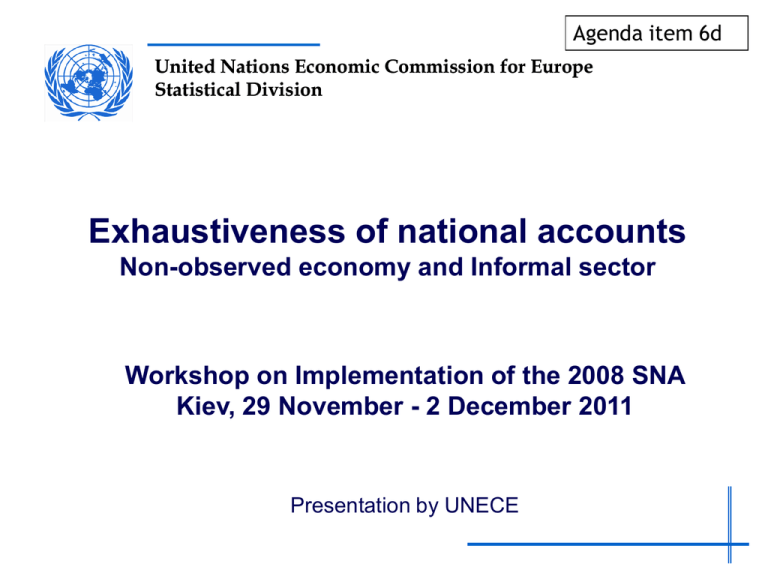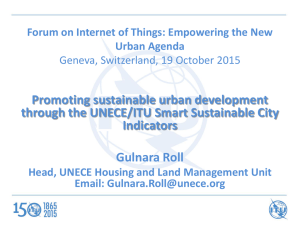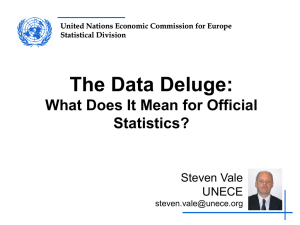Agenda item 6d
advertisement

Agenda item 6d United Nations Economic Commission for Europe Statistical Division Exhaustiveness of national accounts Non-observed economy and Informal sector Workshop on Implementation of the 2008 SNA Kiev, 29 November - 2 December 2011 Presentation by UNECE Objective and Definition All activities within the SNA production boundary should be included Non-observed economy refers to all productive activities that may not be captured in the regular statistical enquiries, that is, activities that are not directly observed. • • 23 July 2016 The aim is to make national accounts exhaustive (quality aspects). Statistics are impartial - from NA perspective not important whether what is produced are “goods” or “bads”, whether produced legally/illegally, by registered/unregistered enterprises etc. - UNECE Statistical Division Slide 2 Exhaustive Measurement issues Lack of coverage causes problems for users both in terms of levels and trends Levels • • Trends • GDP and other data downward biased – inaccurate impression of economy Great significance in situations - monetary contributions made/received by a country depend on its GDP or when poverty is measured by GDP per head etc. Biases in trend estimates can be expected if the economic activities missing from GDP grow at different rates from those included For National Accountants, lack of coverage causes imbalances in the internal consistency of the accounts 23 July 2016 - UNECE Statistical Division Slide 3 Exhaustiveness in the 2008 SNA It is not an issue only for developing countries, although it affects measurement of production in these countries more. Chapter 25 in the 2008 SNA – Informal aspects of the economy • Ensure all activities (incl. hidden and underground) are encompassed in measures of total, • Define and measure Informal activities. 23 July 2016 - UNECE Statistical Division Slide 4 Non-observed economy and Informal Sector Not observed, not informal Observed, informal Not observed, informal 23 July 2016 - UNECE Statistical Division Slide 5 Conceptual framework The 2008 SNA Measuring the Non-Observed Economy. Handbook (2002) – jointly prepared by OECD, IMF, ILO and CISSTAT ILO 15th ICLS, Delhi Group on Informal Sector Eurostat Pilot Projects on Exhaustiveness in 1998 and 2002 – Guidelines on Tabular Frameworks UNECE surveys on country practices in measuring the NOE (1993, 2002, 2005/06) 23 July 2016 - UNECE Statistical Division Slide 6 Non-Observed economy Measuring the Non-Observed Economy. Handbook (2002) http://www.unece.org/stats/documents/2007/04/noe/zip.30.r.pdf - in Russian 5 problem areas: 1) Underground production 2) Illegal production 3) Informal sector production 4) Household production for own final use 5) Deficiencies in data collection 23 July 2016 - UNECE Statistical Division Slide 7 Informal Sector: ICLS & SNA differences 1)Typology of production units • part of SNA households and household enterprises as market producers belongs to ICLS formal sector (meaning of sector different from SNA) 2) Segmenting the economy • • Informal own account enterprises and enterprises of informal employers Criterion of non-registration in many countries does not coincide with lack of legal entity and complete set of accounts 3) Criterion of market producers – ‘some or all’ vs. ‘most or all’ 4) Special cases: ICLS excludes owner-occupied dwellings, services for own final use by paid domestic staff, treats separately agricultural and non-agricultural activities. 23 July 2016 - UNECE Statistical Division Slide 8 Eurostat tabular approach Developed for the projects on Exhaustiveness of National Accounts with EU Candidate Countries First project (1998 – 2000): Tabular approach T1 –T8; Second Project (2002 – 2003): refined Tabular approach to exhaustiveness N1 – N7 23 July 2016 - UNECE Statistical Division Slide 9 Eurostat tabular approach Defines standard set of non-exhaustiveness types (N1 to N7) and presents them in a tabular framework; Provides a comprehensive and systematic assessment to ensure exhaustiveness of NA; Facilitates cross-country comparisons of adjustments and adjustment methods and provides for similar level of coverage of NA. However, the distinction between the N-types is important but it is not the main goal; Main goal: produce accurate NA and GDP estimates. 23 July 2016 - UNECE Statistical Division Slide 10 Total economy (all activities of all producers) Covered by enterprise surveys Yes No Not -surveyed Surveyed Administrative registration? Yes No Not registered No Registered Deliberately Not Required not registered to Register N1 Responding? N3 Yes Non-response incorrectly handled Legal person Enterpreneur N4 N5 N7a Not all data are available N7b Misreporting N6 Illegal producer N2 Slide 11 Measurement of Non-Observed economy Measurement of NOE involves action on two fronts: 23 July 2016 Improvements in direct measurement by the data collection programme, resulting in fewer non-observed activities and hence fewer nonmeasured activities; and Improvements in indirect measurement during compilation of the national accounts, resulting in fewer non-measured activities. - UNECE Statistical Division Slide 12 Exhaustiveness – NA methods Indirect methods of covering NOE in the GDP estimate: • • • • Supply based approaches, including LIM; Demand based approaches; Income based approaches; Commodity flow approaches. Labour Input Method (LIM) is the most important procedure that has been used since 1950s to measure contribution of unorganised sector to GDP. 23 July 2016 - UNECE Statistical Division Slide 13 Supply and use framework commodity flow method at the level of the whole economy • • • • • breakdown of total output or sales by product for goods and services data on exports and imports of goods and services. estimates of the ratios of intermediate consumption to output for various industries. total intermediate consumption by product, final household consumption expenditure, gross fixed capital formation, and changes in inventories by product balancing – removing inconsistencies for the benchmark year and subsequent years 23 July 2016 - UNECE Statistical Division Slide 14 UNECE Surveys on country practices UNECE surveys • 1991: 9 countries 2001/02: 29 countries 2005/06: 43 countries • • Inventory of current methods and practices in estimating NOE Implications and effects on National Accounts 23 July 2016 - UNECE Statistical Division Slide 15 UNECE Surveys on country practices EU member countries - from ~ 1% to ~ 18.9% (from 6.6 to 18.9 among new EU members) EECCA countries - from 10.7 % to 31.6% SEE countries - from 8.8 % to 30.6 % Turkey (1.7%); Mongolia (between 13.0% and 30.0%) Armenia 2003 28.9 Moldova 2001 31.6 Azerbaijan 2003 20.7 Russia 2003 24.3 Belarus 2003 10.7 Tajikistan Year not stated 25 Georgia 2004 28.3 Turkmenistan 2005 18.1 Kazakhstan 2003 21.6 Ukraine 2003 17.2 Kyrgyzstan 2003 17.0 Uzbekistan Year not stated 29-30 23 July 2016 - UNECE Statistical Division Slide 16 Problems in the countries of the region Overall infrastructure Large number of unregistered enterprises, irregular and individual activities, unregistered employed persons High turnover of enterprises, changes in types of economic activities Statistical infrastructure Links between all administrative registers and the statistical business register Use of exhaustive and updated business register as a base for all establishments surveys Difficulties related to sample surveys Difficult to check the reliability of reported data Measuring illegal activities Etc. 23 July 2016 - UNECE Statistical Division Slide 17 Adjustments to NOE Activities NR N1 N2 NS N3 Armenia V V Azerbaijan V V Belarus V V Kazakhstan V Kyrgyzstan N5 O N6 N7 V V V V V V V V V Republic of Moldova V V V Russian Federation V V V V Tajikistan V V V V Turkmenistan V V V Ukraine V V V Uzbekistan V V Georgia V V Mongolia V V Albania V Montenegro V Serbia V V Croatia V V The FYR Macedonia V V V Turkey V V V 23 July 2016 V N4 M V V V V V V V V V V V V V V V V V V V V V V V - UNECE Statistical Division Source: UNECE, 2008 Slide 18 Improvement of basic data Statistical data requirements • make known the requirements and data problems of GDP compilation to the branch statisticians inform main users about the NOE problem areas • Institutional framework • legislation, access to administrative data, relation between confidentiality and non-response or misreporting Conceptual framework of data collection • units, classifications Data collection mechanisms • 23 July 2016 administrative sources, statistical business register, surveys - UNECE Statistical Division Slide 19 Implementation strategy Steps: Formulate aims, consult internal and external users Select an analytical framework Assess NA and basic data collection programme Identify and prioritise NOE improvements Special features in transition countries: priorities: underground, informal analytical framework linked to priorities introducing sample surveys cooperation with other government agencies 23 July 2016 - UNECE Statistical Division Slide 20 Issues for discussion Is Eurostat tabular framework best fitted for NA for the region ? Why large portion of units are still in nonobserved, while registration is required ? Use of better coordination with all administrative registers • Country experiences for measuring the NOE 23 July 2016 Illegal, underground activities; Own-account non-agricultural goods production solely for own final use Statistical underground Informal sector enterprises - UNECE Statistical Division Slide 21



